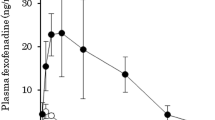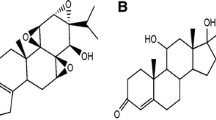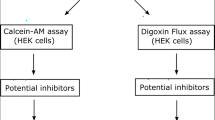Abstract
Purpose. The purpose of this study was to investigate the effects of flavonoids biochanin A and silymarin on intestinal absorption of P-gp substrates by determining their effects on P-gp-mediated efflux in Caco-2 cells.
Methods. The cellular accumulation and bidirectional transport of digoxin and vinblastine in Caco-2 cells were determined in the presence and absence of flavonoids.
Results. The 1.5-h accumulation of digoxin and vinblastine in Caco-2 cells was significantly increased by 50 μM biochanin A or silymarin, and this effect was flavonoid-concentration dependent. The AP-to-BL transport of digoxin was significantly increased, whereas the BL-to-AP transport was significantly decreased by 50 μM biochanin A or 75 μM silymarin. At 150 μM concentrations of biochanin A or silymarin, mean transport ratios (P app,B-A/P app,A-B) of 1.62 and 4.48, respectively, compared with the control ratio of 43.4, were obtained. Conclusion. These results indicate that biochanin A and silymarin can inhibit P-gp-mediated efflux in Caco-2 cells, suggesting they could potentially increase the absorption/bioavailability of coadministered drugs that are P-gp substrates.
Similar content being viewed by others
REFERENCES
R. L. Juliano and V. Ling. A surface glycoprotein modulating drug permeability in Chinese hamster ovary cell mutants. Biochim. Biophys. Acta 455:152-162 (1976).
D. M. Bradshaw and R. J. Arceci. Clinical relevance of transmembrane drug efflux as a mechanism of multidrug resistance. J. Clin. Oncol. 16:3674-3690 (1998).
M. P. Di Marco, D. J. Edwards, I. W. Wainer, and M. P. Ducharme. The effect of grapefruit juice and seville orange juice on the pharmacokinetics of dextromethorphan: the role of gut CYP3A and P-glycoprotein. Life Sci. 71:1149-1160 (2002).
M. F. Fromm, R. B. Kim, C. M. Stein, G. R. Wilkinson, and D. M. Roden. Inhibition of P-glycoprotein-mediated drug transport: A unifying mechanism to explain the interaction between digoxin and quinidine [see comments]. Circulation 99:552-557 (1999).
U. A. Germann. P-glycoprotein—a mediator of multidrug resistance in tumour cells. Eur. J. Cancer 32A:927-944 (1996).
S. V. Ambudkar, S. Dey, C. A. Hrycyna, M. Ramachandra, I. Pastan, and M. M. Gottesman. Biochemical, cellular, and pharmacological aspects of the multidrug transporter. Annu. Rev. Pharmacol. Toxicol. 39:361-398 (1999).
A. H. Schinkel. Pharmacological insights from P-glycoprotein knockout mice. Int. J. Clin. Pharmacol. Ther. 36:9-13 (1998).
U. Mayer, E. Wagenaar, B. Dorobek, J. H. Beijnen, P. Borst, and A. H. Schinkel. Full blockade of intestinal P-glycoprotein and extensive inhibition of blood-brain barrier P-glycoprotein by oral treatment of mice with PSC833. J. Clin. Invest. 100:2430-2436 (1997).
K. V. Speeg, A. L. Maldonado, J. Liaci, and D. Muirhead. Effect of cyclosporine on colchicine secretion by the kidney multidrug transporter studied in vivo. J. Pharmacol. Exp. Ther. 261:50-55 (1992).
V. J. Wacher, C. Y. Wu, and L. Z. Benet. Overlapping substrate specificities and tissue distribution of cytochrome P450 3A and P-glycoprotein: implications for drug delivery and activity in cancer chemotherapy. Mol. Carcinog. 13:129-134 (1995).
F. P. Guengerich. In vitro techniques for studying drug metabolism. J. Pharmacokinet. Biopharm. 24:521-533 (1996).
C. L. Cummins, W. Jacobsen, and L. Z. Benet. Unmasking the dynamic interplay between intestinal P-glycoprotein and CYP3A4. J. Pharmacol. Exp. Ther. 300:1036-1045 (2002).
H. P. Lee, L. Gourley, S. W. Duffy, J. Esteve, J. Lee, and N. E. Day. Dietary effects on breast-cancer risk in Singapore. Lancet 337:1197-1200 (1991).
H. Kohno, T. Tanaka, K. Kawabata, Y. Hirose, S. Sugie, H. Tsuda, and H. Mori. Silymarin, a naturally occurring polyphenolic antioxidant flavonoid, inhibits azoxymethane-induced colon carcinogenesis in male F344 rats. Int. J. Cancer 101:461-468 (2002).
M. G. Hertog, E. J. Feskens, P. C. Hollman, M. B. Katan, and D. Kromhout. Dietary antioxidant flavonoids and risk of coronary heart disease: the Zutphen Elderly Study. Lancet 342:1007-1011 (1993).
S. M. Potter, J. A. Baum, H. Teng, R. J. Stillman, N. F. Shay, and J. W. Erdman, Jr. Soy protein and isoflavones: their effects on blood lipids and bone density in postmenopausal women. Am. J. Clin. Nutr. 68:1375S-1379S (1998).
E. Middleton, Jr., C. Kandaswami, and T. C. Theoharides. The effects of plant flavonoids on mammalian cells: implications for inflammation, heart disease, and cancer. Pharmacol. Rev. 52:673-751 (2000).
B. H. Havsteen. The biochemistry and medical significance of the flavonoids. Pharmacol. Ther. 96:67-202 (2002).
C. B. Powell, S. L. Dibble, J. E. Dall'Era, and I. Cohen. Use of herbs in women diagnosed with ovarian cancer. Int. J. Gynecol. Cancer 12:214-217 (2002).
D. M. Eisenberg, R. C. Kessler, M. I. Van Rompay, T. J. Kaptchuk, S. A. Wilkey, S. Appel, and R. B. Davis. Perceptions about complementary therapies relative to conventional therapies among adults who use both: results from a national survey. Ann. Intern. Med. 135:344-351 (2001).
H. Ni, C. Simile, and A. M. Hardy. Utilization of complementary and alternative medicine by United States adults: results from the 1999 national health interview survey. Med. Care 40:353-358 (2002).
F. Ruschitzka, P. J. Meier, M. Turina, T. F. Luscher, and G. Noll. Acute heart transplant rejection due to Saint John's wort. Lancet 355:548-549 (2000).
S. C. Piscitelli, A. H. Burstein, D. Chaitt, R. M. Alfaro, and J. Falloon. Indinavir concentrations and St John's wort. Lancet 355:547-548 (2000).
P. van de Weijer and R. Barentsen. Isoflavones from red clover (Promensil(R)) significantly reduce menopausal hot flush symptoms compared with placebo. Maturitas 42:187(2002).
J. B. Howes, D. Sullivan, N. Lai, P. Nestel, S. Pomeroy, L. West, J. A. Eden, and L. G. Howes. The effects of dietary supplementation with isoflavones from red clover on the lipoprotein profiles of post menopausal women with mild to moderate hypercholesterolaemia. Atherosclerosis 152:143-147 (2000).
B. P. Jacobs, C. Dennehy, G. Ramirez, J. Sapp, and V. A. Lawrence. Milk thistle for the treatment of liver disease: a systematic review and meta-analysis. Am. J. Med. 113:506-515 (2002).
S. C. Piscitelli, E. Formentini, A. H. Burstein, R. Alfaro, S. Jagannatha, and J. Falloon. Effect of milk thistle on the pharmacokinetics of indinavir in healthy volunteers. Pharmacotherapy 22:551-556 (2002).
S. Zhang and M. E. Morris. Effects of the flavonoids biochanin A, morin, phloretin and silymarin on P-glycoprotein-mediated transport. J. Exp. Pharmacol. and Ther. 304:1258-1267 (2003).
U. K. Walle, A. Galijatovic, and T. Walle. Transport of the flavonoid chrysin and its conjugated metabolites by the human intestinal cell line Caco-2. Biochem. Pharmacol. 58:431-438 (1999).
J. Gao, O. Murase, R. L. Schowen, J. Aube, and R. T. Borchardt. A functional assay for quantitation of the apparent affinities of ligands of P-glycoprotein in Caco-2 cells. Pharm. Res. 18:171-176 (2001).
C. R. Fairchild, J. A. Moscow, E. E. O'Brien, and K. H. Cowan. Multidrug resistance in cells transfected with human genes encoding a variant P-glycoprotein and glutathione S-transferase-pi. Mol. Pharmacol. 37:801-809 (1990).
J. W. Critchfield, C. J. Welsh, J. M. Phang, and G. C. Yeh. Modulation of adriamycin accumulation and efflux by flavonoids in HCT-15 colon cells. Activation of P-glycoprotein as a putative mechanism. Biochem. Pharmacol. 48:1437-1445 (1994).
G. Scambia, F. O. Ranelletti, P. B. Panici, R. De Vincenzo, G. Bonanno, G. Ferrandina, M. Piantelli, S. Bussa, C. Rumi, M. Cianfriglia, and S. Mancuso. Quercetin potentiates the effect of adriamycin in a multidrug-resistant MCF-7 human breast-cancer cell line: P-glycoprotein as a possible target. Cancer Chemother. Pharmacol. 34:459-464 (1994).
F. Tang, K. Horie, and R. T. Borchardt. Are MDCK cells transfected with the human MDR1 gene a good model of the human intestinal mucosa? Pharm. Res. 19:765-772 (2002).
F. Tang, K. Horie, and R. T. Borchardt. Are MDCK cells transfected with the human MRP2 gene a good model of the human intestinal mucosa? Pharm. Res. 19:773-779 (2002).
H. J. Maeng, H. J. Yoo, I. W. Kim, I. S. Song, S. J. Chung, and C. K. Shim. P-glycoprotein-mediated transport of berberine across Caco-2 cell monolayers. J. Pharm. Sci. 91:2614-2621 (2002).
Author information
Authors and Affiliations
Corresponding author
Rights and permissions
About this article
Cite this article
Zhang, S., Morris, M.E. Effect of the Flavonoids Biochanin A and Silymarin on the P-Glycoprotein-Mediated Transport of Digoxin and Vinblastine in Human Intestinal Caco-2 Cells. Pharm Res 20, 1184–1191 (2003). https://doi.org/10.1023/A:1025044913766
Issue Date:
DOI: https://doi.org/10.1023/A:1025044913766




